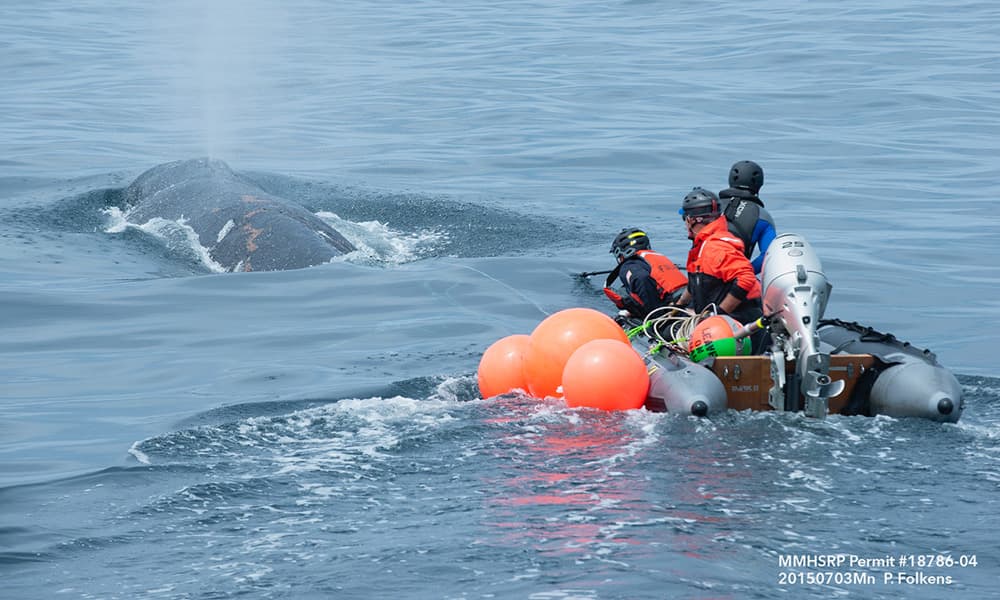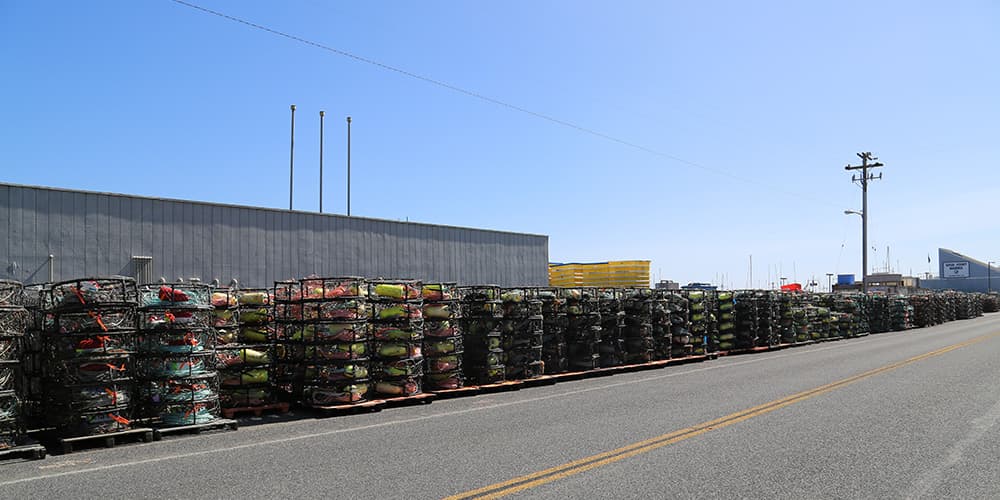Whale Entanglement

Entanglement is an increasing problem globally. It affects many species of marine mammals and can be fatal. Whale entanglement may occur with gear associated with certain fisheries or other operations that put nets, lines, or other equipment into the ocean. For smaller marine mammals like porpoises, dolphins, seals, and sea lions, death is typically due to drowning or other fatal impacts. Large whales, such as endangered humpback and blue whales, can carry entangling gear for months at a time and over thousands of miles, causing exhaustion, starvation, physical trauma, infection, restricted movement, and potential drowning. It may also put whales at greater risk of other threats, such as ship strikes.
In recent years, the number of whales entangled in fishing gear off California has increased dramatically. The reason for the spike in reports of such events may be from multiple factors, including larger whale populations, improved reporting, and a shift in whale distribution into more hazardous areas.
Humpback whales that feed throughout national marine sanctuary waters are increasing in number. However, they are part of the Mexican and Central American distinct population segments, which remain on the Endangered Species List. Humpback whales have been feeding closer to shore off much of the West Coast in recent years. Changing ocean conditions have caused their prey, especially baitfish such as anchovies, to become increasingly abundant in cooler nearshore waters. This nearshore movement has recently been identified as a factor contributing to an increase in whale-gear interactions.
In addition, an increase in the number and awareness of knowledgeable on-the-water observers likely to report entangled animals (e.g., whale watching, recreational boating, fishermen, and women) has also improved reporting.
Whale species most at risk to entanglement: Humpback whale, gray whale, blue whale
Working Together to Reduce Whale Entanglement Incidents
NOAA's National Marine Fisheries Service and the California Department of Fish and Wildlife have prioritized addressing the increasing incidence of whale entanglements in California waters in partnership with the California Ocean Protection Council. In response, a diverse stakeholder group of commercial and recreational fishermen, environmental organization representatives, members of NOAA's Large Whale Entanglement Response Team, and state and federal agency staff set out to address risk reduction for entanglements in Dungeness crab fishing gear by forming the California Dungeness Crab Fishing Gear Working Group. Strategies included developing a Risk Assessment & Mitigation Framework, producing a guide for best fishing practices, and exploring gear modification such as ropeless technologies. Staff from Monterey Bay National Marine Sanctuary serve as the regional sanctuaries' representatives for entanglement and engage in collaborative efforts to reduce threats to sanctuary resources and wildlife.

Participation in the NOAA West Coast Large Whale Entanglement Response Program
Greater Farallones and Channel Islands National Marine Sanctuaries participate in the West Coast Large Whale Entanglement Response Program, lending support to Southern and North-Central California response efforts. Monterey Bay National Marine Sanctuary supports the West Coast response team by providing telemetry, vessel support, and other specialized equipment needed for these operations. The National Marine Sanctuary Foundation and the State of California provide funding for rescue equipment and annual training for sanctuary staff and volunteers on response protocols.
Research in Sanctuaries Protects Whales from Entanglement
Data from studies of whales in Cordell Bank and Greater Farallones national marine sanctuaries inform strategies and efforts to protect whales in these sanctuaries. Sanctuary scientists, together with researchers from Point Blue Conservation Science, collaborate in the Applied California Current Ecosystem Studies (ACCESS) program to study the distribution of whales, seabirds and prey, and document oceanographic conditions. These quarterly research cruises provide data used to identify high entanglement risk areas due to fisheries operations.
Who May Disentangle Whales?
Only those explicitly operating under the NOAA Fisheries' National Marine Mammal Health and Stranding Response Program (MMHSRP) and acting under a NOAA Fisheries' MMHSRP permit, properly trained and equipped to manage entanglement responses, are authorized to attempt rescues.
Whale rescue is complex and dangerous for the rescuers as well as the whale. Unauthorized rescue attempts can result in failed efforts, can further injure the whale, and may even thwart the NOAA team's efforts. If an injury occurs to anyone during a rescue attempt, the entire NOAA response program will be shut down. Do not attempt to disentangle a whale yourself. NOAA teams all along the coast are appropriately trained, experienced, and equipped for marine mammal disentanglement. Instead, learn how you can help.
Only members of a NOAA-authorized response team may attempt whale disentanglement.
To report entangled marine mammals or sea turtles, immediately contact:
- For whales, dolphins: Entanglement Reporting Hotline: 1-877-SOS-WHALE or 1-877-767-9425
- The U.S. Coast Guard: VHF Ch. 16
To report entangled pinnipeds or sea turtles:
Contact The Marine Mammal Center - 1-415 289-SEAL (1-415-289-7325)
Lost Gear Removal
The sanctuaries work with the California Department of Fish and Wildlife (CDFW), which sponsors a permit program to authorize fishery-related groups to remove lost or abandoned gear during and after the season. The sanctuaries provide gear coordinates to CDFW, who then retrieve the gear and coordinate with fishing associations to return or dispose of the equipment.

